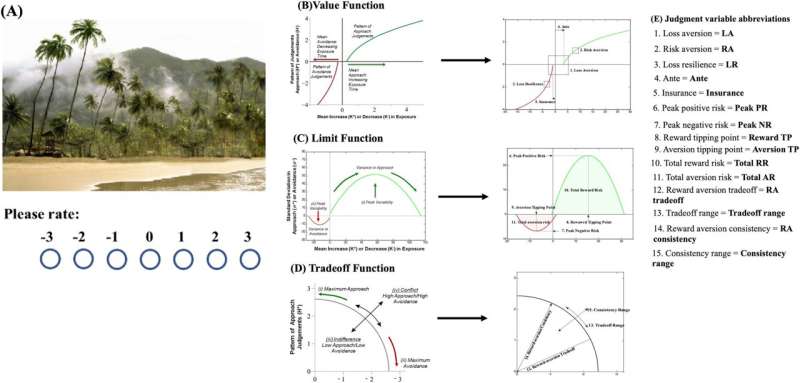
Image rating task and rating variable extraction. Credit: npj Mental health research (2024). DOI: 10.1038/s44184-024-00074-x
Researchers at the University of Cincinnati have developed a new form of artificial intelligence that uses a short assessment task and a small set of contextual variables to predict whether someone is experiencing anxiety.
Anxiety can be functionally disabling, affecting 12% of the US population as the leading cause of disability. It is characterized by intense fear and persistent worry in the absence of a defined threat. Chronic anxiety can damage a person’s mental and physical health, affecting relationships, careers and quality of life.
“I feel like anxiety is experienced by everyone at different levels and stages of life, and is a relatable problem for most people,” said Sumra Bari, first author and senior research associate in UC’s College of Engineering and Applied Science.
“We used minimal computational resources and a small set of variables to predict anxiety levels. A key set of these variables quantifies processes important for judgment. We have called this approach ‘Comp Cog AI’ because it integrates computational cognition with artificial intelligence .”
Rather than sifting through vast amounts of social, medical or psychological data (an aspect of ‘big data’) and using power-hungry supercomputers, this technique focuses on a short judgment task in which the individual attaches positive or negative ratings to images assigns and responds to it. a limited number of contextual questions, such as age and loneliness.
“A lot of attention has been paid to using big data for predictions,” says Hans Breiter, co-author and principal investigator of the study.
Breiter is professor of computer science and biomedical engineering at the University of Cincinnati, and adjunct psychiatry at Massachusetts General Hospital and Harvard Medical School.
“Big data-based predictions are powerful, but are challenged by how you interpret such predictions,” he said.
“Having a small number of variables, rooted in mathematical psychology, appears to circumvent this problem and is necessary if current machine learning is ever to approach the question of artificial general intelligence, or what brains routinely do for multiple cognitive functions. The current work is based on a series of equations about human judgment that support the concept of what other AI scientists call a ‘standard model of the mind’.”
The study was published in npj Mental health research. It concluded that across some demographics, assessment measures play a key role in predicting the level of anxiety an individual experiences.
The system represents a “concierge prototype” of a tool that could be an app for medical professionals, hospitals or the military to identify those at urgent risk of anxiety.
Participants, whose demographics matched those of the United States based on U.S. Census Bureau figures, completed the research survey on their personal digital devices and answered questions about demographic characteristics and perceived loneliness.
These 3,476 participants also rated the extent to which they liked or disliked 48 photos depicting mildly emotional subjects. The photo rating data was used to quantify mathematical features of people’s judgments. This data was then used with machine learning algorithms to predict current anxiety levels based on the state anxiety portion of the State-Trait Anxiety Inventory.
“Using an image judgment task with contextual variables that influence judgment may seem simple, but understanding preference patterns allows us to uncover the critical components for a wide range of behaviors,” says co-senior author Aggelos Katsaggelos, the Joseph Cummings Professor of Electrical and Computer Engineering at McCormick and director of the Image and Video Processing Lab at Northwestern University.
Using this new form of artificial intelligence, developed by UC and Northwestern, the technology was able to predict with up to 81% accuracy whether a respondent was likely to suffer from higher or lower levels of anxiety. The system also scored highly on sensitivity and specificity: performance measures that indicate how well the model classifies people with higher levels of anxiety and those who do not.
Bari noted, “The photo review task can be used to take daily and unbiased snapshots of a person’s mental health status, without asking direct questions that could evoke negative or disturbing feelings.”
She added that direct questions about anxiety may be less effective over time because respondents eventually tend to answer the same questions by rote. The new technology is also independent of native language and can be widely used in various settings to assess anxiety.
Researchers noted that the anonymous data was collected from the US population during the COVID-19 pandemic, during which there were reports of higher-than-normal rates of loneliness and anxiety.
More information:
Sumra Bari et al., A Novel Approach to Predicting Anxiety Levels Using Small Sets of Assessment and Research Variables, npj Mental health research (2024). DOI: 10.1038/s44184-024-00074-x
Quote: Study shows AI can predict anxiety levels with picture tasks (2024, June 18), retrieved June 18, 2024 from https://medicalxpress.com/news/2024-06-ai-anxiety-picture-tasks.html
This document is copyrighted. Except for fair dealing purposes for the purpose of private study or research, no part may be reproduced without written permission. The content is provided for informational purposes only.
 Healthy Famz Healthy Family News essential tips for a healthy family. Explore practical advice to keep your family happy and healthy.
Healthy Famz Healthy Family News essential tips for a healthy family. Explore practical advice to keep your family happy and healthy.


